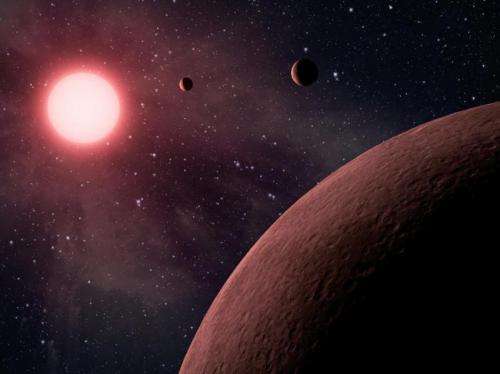October 11, 2016 report
24 new isolated exoplanet star systems found that could qualify as 'hot Earths'

(Phys.org)—A team of researchers with members from NASA Ames Research Center, the SETI Institute and the University of Nevada has identified 24 "hot Earth" star systems where the planets are isolated from other planets. In their paper published in Proceedings of the National Academy of Sciences, the researchers describe how they began with a large set of possible star system candidates and whittled them down to two dozen by focusing on those that were not in close proximity to other planets.
Hot Earths are Earth-sized exoplanets that exist close to their stars, making them interesting but unlikely to support life, because most do not rotate—instead, like the moon relative to the Earth, one side always faces the sun. This means one side would be too hot for life to exist while the other side would be too cold.
In this new study, the researchers were interested in looking at near Earth-size planets that orbit very close to their star—so close that it would take just two days for them to make the trip. They started with a part of the sky captured by Kepler that had over 3000 known planet candidates in it—they sifted those down to 144 planets by excluding systems that clearly had more than one planet and then reduced the number down to just 24 by including only those that had hot Earths. Their sifting efforts led to them estimate that approximately one of every six hot Earths has no nearby companion. The researchers acknowledge it is possible that the solitary hot Earths they found do have companions that were not within Kepler's line of sight, or had paths that were tilted respective to our own view.
The researchers were looking for hot Earths to better understand how they come about—some theories suggest they are the remnants of hot Jupiter planets that have lost their atmospheres due to the strong pull from their nearby stars. Another idea is that the exoplanets started their migrations prior to the formation of other companions. There is also the possibility that interaction between other planets drove the smaller planets out of another system into their current systems.
More information: A Population of planetary systems characterized by short-period, Earth-sized planets, Jason H. Steffen, PNAS, DOI: 10.1073/pnas.1606658113
Abstract
We analyze data from the Quarter 1–17 Data Release 24 (Q1–Q17 DR24) planet candidate catalog from NASA's Kepler mission, specifically comparing systems with single transiting planets to systems with multiple transiting planets, and identify a population of exoplanets with a necessarily distinct system architecture. Such an architecture likely indicates a different branch in their evolutionary past relative to the typical Kepler system. The key feature of these planetary systems is an isolated, Earth-sized planet with a roughly 1-d orbital period. We estimate that at least 24 of the 144 systems we examined (≳≳17%) are members of this population. Accounting for detection efficiency, such planetary systems occur with a frequency similar to the hot Jupiters.
Journal information: Proceedings of the National Academy of Sciences
© 2016 Phys.org




















